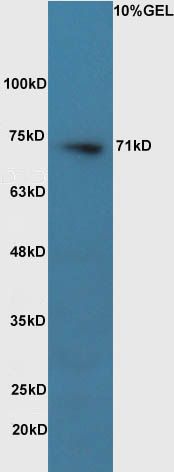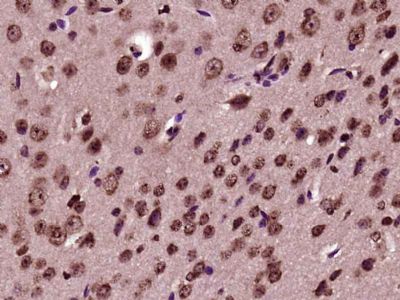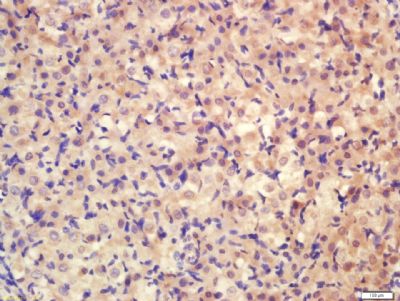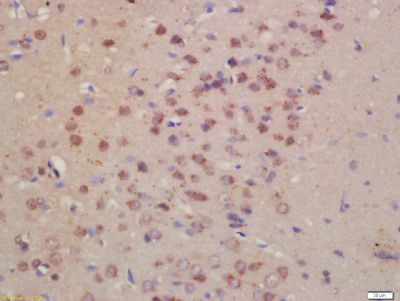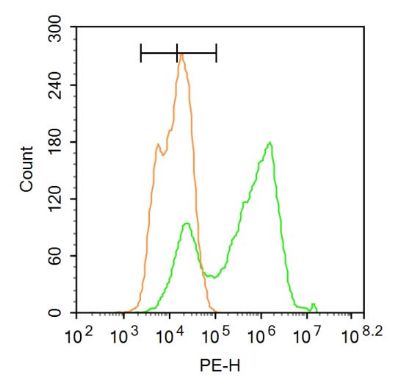NRG1 (Neuregulin 1) is a ligand for ERBB3 and ERBB4 tyrosine kinase receptors. NRG1 concomitantly recruits ERBB1 and ERBB2 coreceptors, resulting in ligand-stimulated tyrosine phosphorylation and activation of the ERBB receptors. There are multiple isoforms of NRG1, the type I isoforms (isoforms 1-8) have an Ig domain and a glycosylation domain. There are 10 known isoforms in total which perform distinct tissue-specific functions. Type I isoforms are the predominant forms expressed in the endocardium. Isoform alpha is expressed in breast, ovary, testis, prostate, heart, skeletal muscle, lung, placenta liver, kidney, salivary gland, small intestine and brain, but not in uterus, stomach, pancreas, and spleen. Isoform 3 is the predominant form in mesenchymal cells and in nonneuronal organs, whereas isoform 5 is the major neuronal form. Isoform 8 is expressed in spinal cord and brain.
Function:
Direct ligand for ERBB3 and ERBB4 tyrosine kinase receptors. Concomitantly recruits ERBB1 and ERBB2 coreceptors, resulting in ligand-stimulated tyrosine phosphorylation and activation of the ERBB receptors. The multiple isoforms perform diverse functions such as inducing growth and differentiation of epithelial, glial, neuronal, and skeletal muscle cells; inducing expression of acetylcholine receptor in synaptic vesicles during the formation of the neuromuscular junction; stimulating lobuloalveolar budding and milk production in the mammary gland and inducing differentiation of mammary tumor cells; stimulating Schwann cell proliferation; implication in the development of the myocardium such as trabeculation of the developing heart. Isoform 10 may play a role in motor and sensory neuron development.
Subunit:
The cytoplasmic domain interacts with the LIM domain region of LIMK1. Interacts with ERBB3 and ERBB4.
Subcellular Location:
Pro-neuregulin-1, membrane-bound isoform: Cell membrane; Single-pass type I membrane protein. Note=Does not seem to be active.
Neuregulin-1: Secreted.
Isoform 8: Nucleus. Note=May be nuclear.
Isoform 9: Secreted. Note=Has a signal peptide.
Isoform 10: Membrane; Single-pass type I membrane protein. Note=May possess an internal uncleaved signal sequence.
Tissue Specificity:
Type I isoforms are the predominant forms expressed in the endocardium. Isoform alpha is expressed in breast, ovary, testis, prostate, heart, skeletal muscle, lung, placenta liver, kidney, salivary gland, small intestine and brain, but not in uterus, stomach, pancreas, and spleen. Isoform 3 is the predominant form in mesenchymal cells and in non-neuronal organs, whereas isoform 6 is the major neuronal form. Isoform 8 is expressed in spinal cord and brain. Isoform 9 is the major form in skeletal muscle cells; in the nervous system it is expressed in spinal cord and brain. Also detected in adult heart, placenta, lung, liver, kidney, and pancreas. Isoform 10 is expressed in nervous system: spinal cord motor neurons, dorsal root ganglion neurons, and brain. Predominant isoform expressed in sensory and motor neurons. Not detected in adult heart, placenta, lung, liver, skeletal muscle, kidney, and pancreas. Not expressed in fetal lung, liver and kidney. Type IV isoforms are brain-specific.
Post-translational modifications:
Proteolytic cleavage close to the plasma membrane on the external face leads to the release of the soluble growth factor form.
N- and O-glycosylated. Extensive glycosylation precedes the proteolytic cleavage.
DISEASE:
Note=A chromosomal aberration involving NRG1 produces gamma-heregulin. Translocation t(8;11) with TENM4. The translocation fuses the 5'-end of TENM4 to NRG1 (isoform 8). The product of this translocation was first thought to be an alternatively spliced isoform. Gamma-heregulin is a soluble activating ligand for the ERBB2-ERBB3 receptor complex and acts as an autocrine growth factor in a specific breast cancer cell line (MDA-MB-175). Not detected in breast carcinoma samples, including ductal, lobular, medullary, and mucinous histological types, neither in other breast cancer cell lines.
Similarity:
Belongs to the neuregulin family.
Contains 1 EGF-like domain.
Contains 1 Ig-like C2-type (immunoglobulin-like) domain.
SWISS:
Q6DR98
Gene ID:
211323
Database links:
Entrez Gene: 3084 Human
Entrez Gene: 211323 Mouse
Omim: 142445 Human
SwissProt: Q02297 Human
Unigene: 453951 Human
Heregulin-β是细胞间信号蛋白,在乳腺上皮细胞形态发生、导管形成,以及诱导乳腺上皮细胞分化成分泌腺泡中起到重要作用,对乳腺发育和乳腺功能调控具有重要意义。
| Picture |
Sample: Raji Cell Lysate at 30ug;
Primary: Anti-HRG beta1 (SL1817R) at 1:300 dilution;
Secondary: HRP conjugated Goat-Anti-Rabbit IgG(SL0295G-HRP) at 1: 5000 dilution;
Predicted band size :71 kD
Observed band size :71 kD
Paraformaldehyde-fixed, paraffin embedded (Mouse brain); Antigen retrieval by boiling in sodium citrate buffer (pH6.0) for 15min; Block endogenous peroxidase by 3% hydrogen peroxide for 20 minutes; Blocking buffer (normal goat serum) at 37°C for 30min; Antibody incubation with (Pro-neuregulin-1, membrane-bound isoform) Polyclonal Antibody, Unconjugated (SL1817R) at 1:400 overnight at 4°C, followed by operating according to SP Kit(Rabbit) (sp-0023) instructionsand DAB staining.
ue/cell: Mouse ovary tissue; 4% Paraformaldehyde-fixed and paraffin-embedded;
Antigen retrieval: citrate buffer ( 0.01M, pH 6.0 ), Boiling bathing for 15min; Block endogenous peroxidase by 3% Hydrogen peroxide for 30min; Blocking buffer (normal goat serum,SLC0005) at 37℃ for 20 min;
Incubation: Anti- HRG Beta1 Polyclonal Antibody, Unconjugated(SL1817R) 1:200, overnight at 4°C, followed by conjugation to the secondary antibody(SP-0023) and DAB(SLC0010) staining
Tissue/cell: rat brain tissue; 4% Paraformaldehyde-fixed and paraffin-embedded;
Antigen retrieval: citrate buffer ( 0.01M, pH 6.0 ), Boiling bathing for 15min; Block endogenous peroxidase by 3% Hydrogen peroxide for 30min; Blocking buffer (normal goat serum,SLC0005) at 37℃ for 20 min;
Incubation: Anti-HRG beta1 Polyclonal Antibody, Unconjugated(SL1817R) 1:200, overnight at 4°C, followed by conjugation to the secondary antibody(SP-0023) and DAB(SLC0010) staining
Blank control:A549.
Primary Antibody (green line): Rabbit Anti-Pro-neuregulin-1, membrane-bound isoform antibody (SL1817R)
Dilution: 1μg /10^6 cells;
Isotype Control Antibody (orange line): Rabbit IgG .
Secondary Antibody : Goat anti-rabbit IgG-PE
Dilution: 3μg /test.
Protocol
The cells were fixed with 4% PFA (10min at room temperature)and then permeabilized with 90% ice-cold methanol for 20 min at-20℃. The cells were then incubated in 5% BSA to block non-specific protein-protein interactions for 30 min at at room temperature .Cells stained with Primary Antibody for 30 min at room temperature. The secondary antibody used for 40 min at room temperature. Acquisition of 20,000 events was performed.
Blank control:A549.
Primary Antibody (green line): Rabbit Anti-Pro-neuregulin-1, membrane-bound isoform antibody (SL1817R)
Dilution: 1μg /10^6 cells;
Isotype Control Antibody (orange line): Rabbit IgG .
Secondary Antibody : Goat anti-rabbit IgG-PE
Dilution: 3μg /test.
Protocol
The cells were fixed with 4% PFA (10min at room temperature)and then permeabilized with 90% ice-cold methanol for 20 min at-20℃. The cells were then incubated in 5% BSA to block non-specific protein-protein interactions for 30 min at at room temperature .Cells stained with Primary Antibody for 30 min at room temperature. The secondary antibody used for 40 min at room temperature. Acquisition of 20,000 events was performed.
|
|
|
